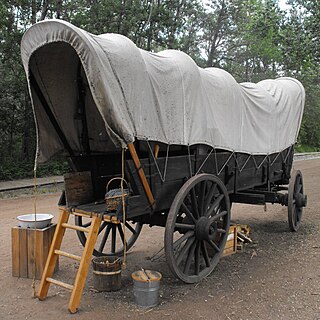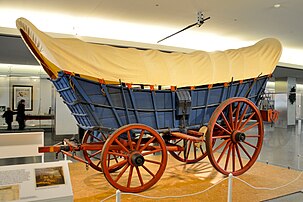Covered wagon
Canvas-covered horse or ox wagons From Wikipedia, the free encyclopedia
A covered wagon, also called a prairie wagon, whitetop,[1] or prairie schooner,[2] is a horse-drawn or ox-drawn wagon used for passengers or freight hauling. It has a canvas, tarpaulin, or waterproof sheet which is stretched over removable wooden bows (also called hoops or tilts) and lashed to the body of the wagon.[3][4][5][6] They were a popular style of vehicle for overland migrations.


Conestoga wagon
The Conestoga wagon was a heavy American wagon of English and German type from the late 18th century and into the 19th century. It was used for freight and drawn by teams of horses or oxen depending on load. The covered canvas top was supported on eight to twelve angled bows, rather than upright. Capacity was around 4 to 5 tons with no springs. Though it was boat-shaped it did not float. It was used in eastern North America for freight hauling, with some used for southward migration through the Appalachian valleys and along the Great Wagon Road. It was too heavy for use west of the Mississippi River; the westward wagons were lighter, and more angular or square.[4]: 55–56
- Conestoga wagons
- Conestoga at National Museum of American History
- Shows framework at Museum of Science and Industry
- Freight Conestoga (Pennsylvania)
America westward expansion
Summarize
Perspective
With roots in the heavy Conestoga wagon developed for the rough, undeveloped roads and paths of the colonial East, the covered wagon spread west with American migration. Typical farm wagons were merely covered for westward expansion and heavily relied upon along such travel routes as the Great Wagon Road, Mormon Trail, Santa Fe Trail, and Oregon Trail, covered wagons carried settlers seeking land, gold, and new futures ever farther west.
Once breached, the moderate terrain and fertile land between the Appalachians and the Mississippi was rapidly settled. In the mid-nineteenth century thousands of Americans took a wide variety of farm wagons[7] across the Great Plains from developed parts of the Midwest to places in the West such as California, Oregon, Utah, Colorado, and Montana. Overland migrants typically fitted any sturdy wagon with several wooden or metal bows which arched high over the bed. Over this was stretched canvas or similar sturdy cloth, creating the distinctive covered wagon silhouette.
For "overlanders" migrating westward, covered wagons were a more common mode of transportation than wheelbarrow, stagecoach, or train. Oxen were the most common draft animal for pulling covered wagons, although mules and horses were also used. Authors of guidebooks written for emigrants noted that oxen were more reliable, less expensive, and nearly as fast as other options.[8]
- Covered wagon at Pipe Spring National Monument
- Covered wagon c. 1870s
- Covered wagons c. 1871
- Covered wagons at California Interpretive Center in Elko, Nevada
Prairie schooner
Prairie schooner is a fanciful name for the covered wagon, drawing on their broad white canvas covers, romantically envisioned as the sails of a ship crossing the sea of prairie grass.[7]
On all the prairie the white-covered wagon was the only sign of human life. It was visible as far as a sail would have been upon the lake, and the prairie, with its graceful undulations that had once been its bottom, waving now with grass, was not unlike the water's surface. A "prairie schooner" was what the settlers called such a wagon.
[A Prairie schooner is an] American emigrant wagon of light/medium weight and dimensions. Headed by a canvas top supported on bow-shaped hoops or tilts. Either sprung or dead axle, up to a capacity of 3 tons. Lever brakes acted on both rear wheels. Drawn by either two or four horses in pole gear. First came to prominence during the gold rush period of the 1840’s. Not to be confused with the much larger Conestoga Wagon.
South Africa Great Trek
During the Great Trek starting in 1836, Dutch-speaking settlers in South Africa travelled by wagon trains, migrating northward from British-ruled areas in search of their own homeland.[9] Mostly pulled by pairs of oxen, the Boer trek wagon had a long wheel-base with the sides higher at the rear in typical Dutch fashion. The wagon had a felt or canvas top supported by bowed hoops.[4]: 17
- Voortrekker covered wagons
- Diagram of wagon and fittings
- Almost exclusively pulled by oxen
- Voortrekker wagon in museum
Freight

Before railroads in early America, ox-teams and wagons were used to haul overland freight, sometimes in great wagon trains of 10 to 60 teams. Each team of 5 to 7 yoked pairs of oxen pulled two wagons—a lead wagon (averaging 6,500 pounds [2,900 kg]), which pulled a trailer wagon (4,000 pounds [1,800 kg]).[10]: 12, 29–30
Military have used covered wagons for transport of supplies. Called "baggage wagons" during the American Revolutionary War, in one account British commander Henry Clinton had a baggage train of 1,500 wagons that stretched 12 miles long.[11]: 192
See also
References
External links
Wikiwand - on
Seamless Wikipedia browsing. On steroids.










